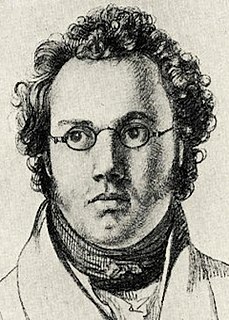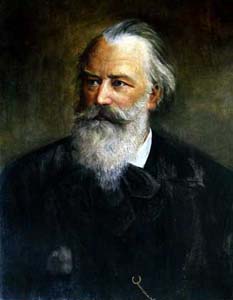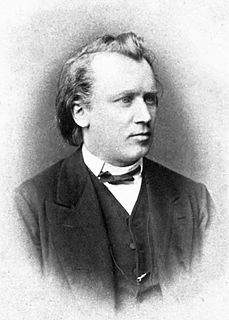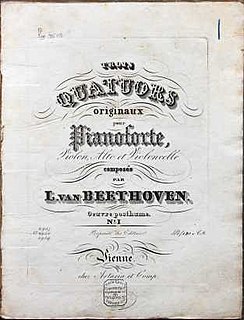Sonata form is a musical structure consisting of three main sections: an exposition, a development, and a recapitulation. It has been used widely since the middle of the 18th century.

The Trout Quintet (Forellenquintett) is the popular name for the Piano Quintet in A major, D. 667, by Franz Schubert. The piano quintet was composed in 1819, when he was 22 years old; it was not published, however, until 1829, a year after his death.

The Piano Quintet in E-flat major, Op. 44, by Robert Schumann was composed in 1842 and received its first public performance the following year. Noted for its "extroverted, exuberant" character, Schumann's piano quintet is considered one of his finest compositions and a major work of nineteenth-century chamber music. Composed for piano and string quartet, the work revolutionized the instrumentation and musical character of the piano quintet and established it as a quintessentially Romantic genre.
The Piano Quintet in F minor, Op. 34, by Johannes Brahms was completed during the summer of 1864 and published in 1865. It was dedicated to Her Royal Highness Princess Anna of Hesse. Like most piano quintets composed after Robert Schumann's Piano Quintet (1842), it is written for piano and string quartet.

The Clarinet Sonatas, Op. 120, Nos. 1 and 2, are a pair of works written for clarinet and piano by the Romantic composer Johannes Brahms. They were written in 1894 and are dedicated to the clarinetist Richard Mühlfeld. The sonatas stem from a period late in Brahms's life where he “discovered” the beauty of the sound and tonal colour of the clarinet. The form of the clarinet sonata was largely undeveloped until after the completion of these sonatas, after which the combination of clarinet and piano was more readily used in composers’ new works. These were the last chamber pieces Brahms wrote before his death and are considered two of the great masterpieces in the clarinet repertoire. Brahms also produced a frequently performed transcription of these works for viola with alterations to better suit the instrument.

The Cello Sonata No. 1 in E minor, Op. 38, entitled "Sonate für Klavier und Violoncello", was written by Johannes Brahms in 1862–65.

Franz Schubert's final chamber work, the String Quintet in C major is sometimes called the "Cello Quintet" because it is scored for a standard string quartet plus an extra cello instead of the extra viola which is more usual in conventional string quintets. It was composed in 1828 and completed just two months before the composer's death. The first public performance of the piece did not occur until 1850, and publication occurred three years later in 1853. Schubert's only full-fledged string quintet, it has been praised as "sublime" or "extraordinary" and as possessing "bottomless pathos," and is generally regarded as Schubert's finest chamber work as well as one of the greatest compositions in all chamber music.

Ludwig van Beethoven's Piano Sonata No. 16 in G major, Op. 31, No. 1, was composed between 1801 and 1802. Although it was numbered as the first piece in the trio of piano sonatas which were published as Opus 31 in 1803, Beethoven actually finished it after the Op. 31 No. 2, the Tempest Sonata.
The six String Quartets, Op. 76 by Joseph Haydn were composed in 1797 or 1798 and dedicated to the Hungarian count Joseph Georg von Erdődy (1754–1824). They form the last complete set of string quartets that Haydn composed. At the time of the commission, Haydn was employed at the court of Prince Nicolaus Esterházy II and was composing the oratorio The Creation as well as Princess Maria Hermenegild Esterházy's annual mass.
The String Quartet No. 2 in A minor, Op. 13, was composed by Felix Mendelssohn in 1827. Written when he was 18 years old, it was, despite its official number, Mendelssohn's first mature string quartet. One of Mendelssohn's most passionate works, the A minor Quartet is one of the earliest and most significant examples of cyclic form in music.
The String Quintet in C major, Op. 29, written by Ludwig van Beethoven, was composed in 1801. This work is scored for string quartet and an extra viola. The Op. 29 is Beethoven's only full-scale, original composition in the string quintet genre; of his other quintet works, the Op. 4 is an extensively reworked arrangement of the earlier Octet for Winds, Op. 103, the String Quintet Op. 104 is an arrangement of an earlier piano trio, and the later fugue is a short work.
Johannes Brahms's Clarinet Quintet in B minor, Op. 115, was written in 1891 for the clarinettist Richard Mühlfeld. It is scored for a clarinet in A with a string quartet. It has a duration of approximately thirty-five minutes.
Antonín Dvořák´s String Sextet in A major, Op. 48, (B. 80) for two violins, two violas and two cellos was composed for the most part in May 1878. It was Dvořák's first work to be premiered outside Bohemia.

The Piano Trio No. 2 in C major, Op. 87, by Johannes Brahms was composed between 1880 and 1882. It is scored for piano, violin and cello.

The Piano Quartet No. 3 in C minor, Op. 60, completed by Johannes Brahms in 1875, is scored for piano, violin, viola and cello. It is sometimes called the Werther Quartet after Goethe's The Sorrows of Young Werther.

The Piano Quartet No. 1 in G minor, Op. 25, was composed by Johannes Brahms between 1856 and 1861. It was premiered in 1861 in Hamburg, with Clara Schumann at the piano. It was also played in Vienna on 16 November 1862, with Brahms himself at the piano supported by members of the Hellmesberger Quartet. Like most piano quartets, it is scored for piano, violin, viola and cello.
The String Sextet No. 1 in B♭ major, Op. 18, was composed in 1860 by Johannes Brahms and premiered in Hanover by an ensemble led by Joseph Joachim. It was published in 1862 by the firm of Fritz Simrock.
Johannes Brahms' String Sextet No. 2 in G major, Opus 36 was composed during the years of 1864–1865 and published by the firm of Fritz Simrock. It was first performed in Boston, Massachusetts on October 11, 1866, with the European premiere following the next month in Zurich. The work is scored for two violins, two violas, and two celli, and has four movements:
- Allegro non troppo
- Scherzo – Allegro non troppo – Presto giocoso
- Adagio
- Poco allegro
String Quintet No. 2 in G major, Op. 111, is a work by Johannes Brahms composed in 1890 and published in 1891. It is known as the Prater Quintet. Brahms intended it to be his last piece of music, though he later produced a number of piano pieces and the two sonatas for clarinet or viola and piano. The first performance of the Quintet in Vienna on November 11, 1890 was a sensation.

The Piano Quartets, WoO 36, by Ludwig van Beethoven are a set of three piano quartets, completed in 1785 when the composer was aged 15. They are scored for piano, violin, viola and cello. He composed a quartet in C major, another in E-flat major, and a third in D major. They were first published posthumously in 1828, however numbered in a different order: Piano Quartet No. 1 in E-flat major, Piano Quartet No. 2 in D major, and Piano Quartet No. 3 in C major.










